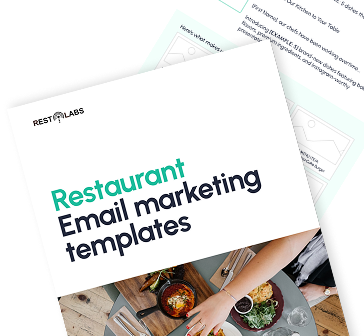Key Takeaways
With the lucrative industry with a market share of $799 billion and over a billion restaurants in the United States alone, it's often taxing for restaurant owners and marketers to get more people into their restaurants and keep the momentum alive.
Almost every marketing idea that can guarantee results costs both time and money. Considering the price of promotions and the fact that not all first-time diners choose to come back – advertisement can seriously put a dent in your revenues.
The Solution?
You must invest in a base of repeat customers - people you can do a regular business with. Email marketing is an effective way to promote your restaurant without spending a lot on administrative costs. Many restaurants have found success through email marketing, allowing them to control their message, speak directly to customers, and target people who are genuinely interested in their food and services.
Email marketing is not only a reasonable way to run promotions, but recent innovations in this domain have made it one of the most preferred advertisement methods for modern age marketers.
“Successful and technologically driven restaurant email marketing is essential and allows you to maintain a good profit regardless of the cuisine you represent.”
Smart personalization with Artificial Intelligence
AI and machine learning capabilities offered by email marketing platforms today help restaurant owners and marketers drive better targeting and results. Gone are the days of “email blasts”, this is the era of personalization. AI-powered tools provide complex personalization that helps marketers deliver relevant content based on a customer's personal interests and behavior pattern. For instance, if someone browsed your online restaurant menu for Chinese food, AI-driven emailer strategy will optimize the content and send times to target the visitor effectively.
AI can inspire authentic digital communication and unlock the world where email marketing feels much more like a real, human-to-human conversation.
Machine learning capabilities allow marketers to create content that resonates best with the likes and interests of the target audience. Based on this insight, the AI-powered email platforms use natural language processing to create subject lines, body copy as well as CTAs that sound like they are written by humans. Imagine the time and cost savings in addition to having an understanding of what worked and what didn’t for your restaurant brand.
The mobile segment
Smartphones are gradually taking over as the most used device on which people check their emails. Statistics show that over 65 percent of users first read emails on their mobile devices. Marketers are already taking heed of this trend and are refashioning their brand newsletters to fit the need. This means that emails will get shorter and precise.
A 2017 research showed that the KISS approach to draft promotional emails works pretty well to serve millennials and generation Z. Decreasing attention span and fast consumption of information are two factors taken into consideration when implementing this strategy.
The rise of visual communication
Who said emails are static and boring? Add in a cool animation or Graphics Interchange Format (GIF) and your email immediately comes to life. Future predictions for email marketing show that emails are set to become more fun and interactive with the inclusion of animations. GIFs and animations have been extremely popular on social media, and now emails are leveraging on this popularity as well.
Animations are great visual communication tools to convey the brand message and capture customers’ attention. They also have a high shareable quality. However, it is unlikely that these features will be used solely and will instead be combined with standard email features like texts, links, images, and call-to-action buttons.
Hyper-Personalisation is all you need
Forget personalization, hyper-personalization is going to become the most ubiquitous word in the email marketing industry for restaurants. If you’re not tailoring your messages to individual needs, then you’re won’t be able to generate customer loyalty for your brand.
When it comes to emails, people tend to filter out content that has no relevance to their needs and aspirations. A man wanting to order only Thai Food from your restaurant will have no interest in Sushis and Dimsums, no matter how popular or bestselling they have been for your restaurant. As a result, your emails will start pouring in your customer’s spam folder.
In our research, it was estimated that restaurants generated 35 percent more revenue from its AI-powered email product recommendations. AI algorithms analyze browsing behavior, on-site activity, as well as the purchase history and use this data to create dynamic and personalized recommendations for every customer- at broads scale. This type of personalization offers as much value to the customer as it does to the marketer.
Machine to machine communication is on the rise
Emails are going through a seismic shift and in the future, you probably won't even have to worry about opening and sending emails. Experts predict that with the rapidly advancing technology and the evolving needs of customers, emails will make a massive switch through increasing machine to machine communication. Restaurant Marketers will need to be extremely tech-savvy while adopting and adapting to newer tools as they come into play.
Getting started with implementing new and innovative restaurant email marketing strategies can be as simple as choosing an emailer platform that supports machine learning. Next is capturing the email addresses of existing as well as potential customers and nurture the subscribers in an engaging manner.
In summary, email marketing is an effective method to augment other marketing efforts to maximize the return on your marketing budget.
Now, it’s your turn!
Are you using email marketing to promote your restaurant? If so, what strategies are working for you? We would love to hear from you; use the comment section below to share your thoughts.
Frequently Asked Questions


.gif)




.png)




